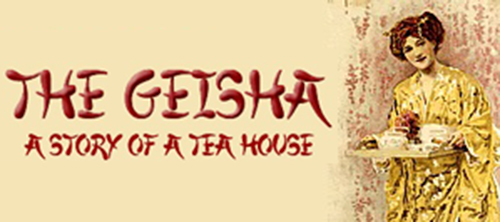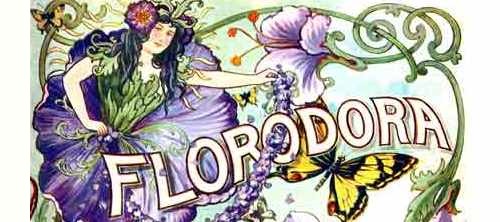Pas de biographie disponible.
Compositeur Musique additionelle Librettiste Parolier Metteur en scène Chorégraphe Producteur création Producteur version

Musical
Musique: Sidney Jones • Paroles: Harry Greenbank • Livret: Owen Hall • Production originale: 1 version mentionnée
Dispo: Synopsis Génèse Liste chansons
Genèse: It opened at Prince of Wales Theatre in London, produced by George Edwardes, on 14 October 1893 (later transferring to Daly's Theatre) and ran for 397 performances. The show starred C. Hayden Coffin, Louie Pounds, Decima Moore, Eric Lewis, W. Louis Bradfield, and later Rutland Barrington, Scott Russell, Huntley Wright, Marie Studholme and George Grossmith, Jr. Topsy Sinden and later Letty Lind danced in the piece. Choreography was by Willie Warde. Percy Anderson designed the Japanese costumes for the musical, while the non-Japanese costumes were supplied by leading fashion houses. Blanche Massey was one of the Gaiety Girls in the piece. It also had a successful three-month Broadway run in 1894, followed by an American tour and a world tour. Importance in the development of the modern musical A Gaiety Girl followed Tanner's and Edwardes's success with In Town (1892), and would lead to a series of musicals produced by Edwardes that would pack the Gaiety Theatre for decades. Although the earliest of these shows have the same sound one expects from Gilbert and Sullivan's operas, Edwardes called them "musical comedies", leading some writers to incorrectly credit him with inventing a form that Harrigan & Hart had established on Broadway a decade earlier. Although Edwardes was not the true inventor of musical comedy, he was the first to elevate these works to international popularity. According to musical theatre writer Andrew Lamb, "The British Empire and America began to fall for the appeal of the British musical comedy from the time when A Gaiety Girl was taken on a world tour in 1894." The plot of A Gaiety Girl is a simple intrigue about a stolen comb and includes a few tangled romances. Hall's satirical book includes lines which jab at society conventions in the style of an upmarket gossip columnist. The smart society back-chat irritated several people in high places in London who wrote to Edwardes asking for alterations. The public, on the other hand, loved it, even when the Reverend Brierly, a character depicted as a man of doubtful moral rectitude, was demoted, after pressure from Lambeth Palace, to being just plain Dr. Brierly. Satire is also directed, among other things, at the army, and the story ridicules a judge of the divorce court, which caused some controversy. A Gaiety Girl's success confirmed Edwardes on the path he was taking. He immediately set Hall, Jones and Greenbank to work on their next show, An Artist's Model. A Gaiety Girl led to some fourteen copies (including The Shop Girl, The Circus Girl, and A Runaway Girl), which were very successful in England for the next two decades, and were widely imitated by other producers and playwriting teams.
Résumé:
Création: 14/10/1893 - Prince of Wales Theatre (Londres) - 397 représ.

Musical
Musique: Lionel Monckton • Sidney Jones • Paroles: Harry Greenbank • Livret: Owen Hall • Production originale: 1 version mentionnée
Dispo: Résumé Commentaire Liste chansons
The Geisha, a story of a tea house est une comédie musicale édouardienne en deux actes. La partition a été composée par Sidney Jones sur un livret d’Owen Hall, avec des paroles de Harry Greenbank. D’autres chansons ont été écrites par Lionel Monckton et James Philp.
Genèse:
Résumé: Acte I Stationné au Japon, loin de sa fiancée Molly, le lieutenant Reggie Fairfax de la Royal Navy se sent seul. Il commence à passer une grande partie de son temps libre à la Maison de thé des Dix Mille Joies qui est dirigée par le Chinois Wun-Hi. Là, il rencontre la geisha O Mimosa San, avec qui il noue une amitié, mais elle est amoureuse de Katana, un soldat, alors elle le décourage avec son histoire de « Le poisson rouge amoureux ». Cependant, Reggie donne à Mimosa une leçon de baiser. La relation ne passe pas inaperçue auprès de Lady Constance Wynne, une aristocrate anglaise en tournée, qui surprend Reggie en train de se livrer à un tête-à-tête avec Mimosa et lui rappelle qu’il est fiancé à Molly. Lady Constance contacte Molly, lui disant de se rendre au Japon le plus rapidement possible. Le seigneur local, le marquis Imari, qui aime aussi Mimosa, est agacé que sa future épouse fréquente les marins britanniques nouvellement arrivés, et il ordonne que la maison de thé soit fermée et que les filles soient vendues. Le marquis lui-même est poursuivi par l’interprète française Juliette. Molly arrive à l’improviste. Laissée seule, Molly est rejointe par Mimosa et Lady Constance, qui lui disent à quel point Reggie est devenu friand d’une geisha en particulier. Mimosa suggère alors à Molly de se déguiser en geisha elle-même pour essayer de le reconquérir. C’est maintenant l’heure de la vente des contrats des geishas. Le marquis essaie de s’acheter du mimosa, mais Lady Constance parvient à surenchérir pour la garder hors de ses griffes. Malheureusement, elle ne peut pas l’empêcher d’acheter le lot numéro 2, une nouvelle geisha appelée Roli Poli que personne n’a vue auparavant. Ce n’est qu’après que le marquis ait fait son achat qu’il est révélé que cette geisha est en fait Molly déguisée. Acte II Dans les jardins de chrysanthèmes du palais d’Imari, Molly, toujours déguisée en Roli Poli, attend son mariage imminent avec le marquis, qui est devenu très attiré par elle. Mimosa propose un plan pour sauver Molly de son destin : Mimosa se faufilera dans la suite nuptiale et échangera la Molly voilée contre une autre mariée voilée - Juliette, l’interprète française. La cérémonie de mariage commence et le plan est mis à exécution : Juliette est échangée avec Molly, et le marquis épouse involontairement la mauvaise épouse. En découvrant la ruse, il accepte son destin avec philosophie, concluant que « tout homme est déçu de sa femme à un moment ou à un autre ». Mimosa est maintenant libre d’épouser son amant Katana, et Molly est réunie avec Reggie, déclarant qu’elle n’épouserait jamais un noble étranger alors qu’elle pourrait avoir un marin britannique.
Création: 25/4/1896 - Daly's Theatre (Londres) - 760 représ.

Musical
Musique: Leslie Stuart • Paul Rubens • Paroles: Edward Boyd-Jones • Paul Rubens • Livret: Owen Hall • Production originale: 2 versions mentionnées
Dispo: Résumé Synopsis Génèse Liste chansons
Genèse: Upon opening in London on 11 November 1899 at the Lyric Theatre, the show originally starred Evie Greene, Willie Edouin and Ada Reeve Running for an astounding-for-the-time 455 performances, and closing in March 1901, the show would prove as a training ground for numerous up-and-coming stars of the British theatre. After moving to the Casino Theatre on Broadway in 1900, the spectacle ran for an astonishing 552 performances – the first instance of a London production achieving such a Broadway run, and only the third longest run on Broadway of any theatre piece up to that time. The show was subsequently mounted in Australia in 1900 by J. C. Williamson where it enjoyed another incredibly long run. In addition to the numerous local productions being mounted throughout the English-speaking world and beyond, including productions translated into more than a dozen languages, the show toured extensively with numerous local touches, and engaging audiences both domestically as well as around the world as a result. The Original Cast Album was made as well, featuring all six original sextet members from the New York Cast: Marie Wilson, Agnes Wayburn, Marjorie Relyea, Vaughn Texsmith, Daisy Green and Margaret Walker. Recorded on a series of six 78 RPM gramophone records with a full libretto enclosed, the album was a first for musical theatre at that time. London's West End staged two successful revivals in 1915 as well as in 1931, and several Broadway revivals enjoyed great success as well, the first being mounted a mere year after the closing of the original production in 1901 followed by another notable foray into the public eye three years later. In one of the more well-known revivals to modern audiences, a young Milton Berle played one of the Florodora Boys in a production mounted for the 1920–21 Broadway season. More recently, the show was revived once again at the Finborough Theatre in January 2006 for the first professional London production that it had enjoyed in many years. Florodora's famous double sextet, "Tell Me Pretty Maiden", became the most successful show tune of its time. Other songs ranged from traditional waltzes such as "The Silver Star of Love" and "The Fellow Who Might" to the more quirky type rhythmic and long-lined dance numbers for which Stuart was known. A good part of the success of the musical was attributed to its lovely sextet of chorines, called "the English Girls" in the score, but soon popularly dubbed the "Florodora Girls". More than 70 women, each 5 ft. 4 in. (about 1.63 m) tall and weighing in at 130 lb (59 kg) played these roles in the first run of the play. Pretty and petite, the girls were also the object of a great deal of popular adoration, and many young male admirers persuaded a good number of the girls in the show to leave and settle down. A 1930 MGM film starring Marion Davies was called The Florodora Girl.[3] and in the Our Gang Follies of 1936 the children's troupe known to modern audiences as The Little Rascals satirized the show in a penny-per-head basement performance.
Résumé: Florodora is a South Sea island ruled by wealthy American Cyrus Gilfain, manufacturer of a perfume named after the island. But the island really belongs to Dolores, whose father was cheated by Cyrus. Cyrus would like to marry Dolores (and therefore legalise his grip on the island) but Dolores is in love with Frank Abercoed, Cyrus’s manager. Meantime Cyrus’s daughter, Angela, is in love with another of Cyrus’s employees, Arthur Donegal! Suddenly Frank comes into a fortune, and inherits a title and an estate in Wales. He and Dolores leave the island for Wales, and Cyrus secretly follows them, planning to find a way of stopping their marriage. Cyrus seeks the help of Lady Holyrood in his scheme to prevent the wedding, but their wicked plans are exposed by the private investigator Anthony Tweedlepunch, who also manages to force Cyrus to return Florodora to its proper owner, Dolores. Following this, all the lovers are properly paired off for a happy ending.
Création: 11/11/1899 - Lyric Theatre (Londres) - 455 représ.

.png)
.png)




